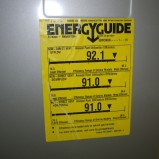Taking steps to reduce your electricity and energy use at home is a smart choice — and the good news is you won’t have to replace all your windows or move to a yurt do it. Here are a few quick and easy projects to get you started.
1. Insulate electrical outlets.
Insulate the electrical outlets in your house that are located on exterior walls. Your local hardware store probably sells foam socket sealers that will help block cold or hot outside air from entering your home. You’ll need a screwdriver to remove the outlet plates or switch plates, but the whole process shouldn’t take more than a few minutes per outlet.
2. Get an energy audit.
Pay attention to your utility bill. Some utility companies occasionally offer a free energy audit, which typically entails a home inspection from a utility employee. If your electric bill seems high and you can’t figure out the reason, getting an audit is a great starting point for investigation; the results will help you understand the factors that may be affecting your energy use, such as drafty windows or a poorly insulated roof.
3. Switch to fluorescent light bulbs.
Replace your incandescent light bulbs with compact fluorescent bulbs or LEDs. Compact fluorescent bulbs are brighter and more efficient than incandescent bulbs; they may be more expensive up front, but they’ll last much longer.
4. Give your fridge a hand.
Vacuum the coils on your refrigerator. Pet hair and dust bunnies accumulate on the coils over time, causing the fridge to have to work harder to get rid of the heat. If you clean off the coils now and then, the fridge will have less work to do and will use less energy.
5. Block off unused heat registers.
Be smart about heating and cooling. Is there a room in your home you rarely use?
6. Close the chimney flue.
If you have a fireplace, make sure the chimney vent is closed, unless you are about to make a fire.
7. Winterize windows and doors.
If you live in a place with long, cold winters and your home is drafty, it’s definitely worth investing in winterizing supplies. Double-sided foam tape can help plug gaps along the edges and bottom of exterior doors and window frames so the wind doesn’t whistle through your kitchen.
8. Turn down appliances.
Check the thermostat in your refrigerator and freezer; your fridge should be set between 37 and 40 degrees and your freezer at about 5 degrees. Hot water heaters are typically set at 140 degrees, but you can probably get away with setting yours at 120 degrees unless you have health concerns that require extra-hot water.
9. Insulate hot water pipes.
If you have easy access to your hot water heater, hot water pipes, and heating ducts, insulate them with foam or insulator foil.
10. Install a programmable thermostat.
A programmable or smart thermostat can save you a bundle on your electric bill by automatically lowering (or raising) the temperature in your home while you’re not there.
11. Install ceiling fans and use them wisely.
Did you know that ceiling fans aren’t just for the summer months? In addition to providing a cool breeze on a hot day, they can also be useful in the wintertime. It all has to do with which direction the blades are rotating. Set your fan turning counterclockwise in the summer to create the most air movement in the center of the room and make you feel cooler. In cooler months, turn it on low in a clockwise direction to send rising warm air to the edges of the room, mixing the warmer and cooler air and keeping your room at a steadier temperature.
Laura Selby | Tue, Jun 26, 2012 | Read the entire post on Yahoo! Homes
Renaissance Homes is an award winning Street of Dreams custom home builder specializing in green building, remodeling and renovations for the Portland market. Visit our Design Studio to personalize your new home.
Awarded the Portland Homebuilder’s Association 2011 “Builder of the Year.”



